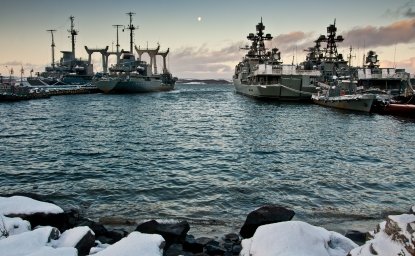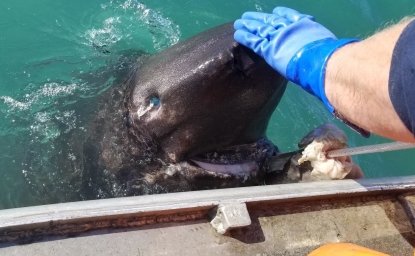
A blog of the Polar Institute
Introduction
Globally speaking, neither the Kingdom of Denmark nor Norway can be viewed as major players. In the Arctic, however, the two states are not only an integral part of any security and governance debate — together they also hold some of the largest land and maritime areas in the High North. Moreover, their strategic position in the North Atlantic is key to United States security concerns and aspirations in the Arctic.
Both the Kingdom of Denmark and Norway have strong interests in maintaining the Arctic as a region of low tension. They are close allies and partners with the United States and understand that the United States is a key player when it comes to securing low tension in the region. At the same time, the United States is dependent on these two Nordic states along various axes, ranging from security affairs to economic development.
The two states have the potential to further collaborate to promote their common interests in the Arctic vis-à-vis the United States. This would increase the impact of their efforts, and their scarce resources could be used in a more strategic manner. When standing together, Norway and the Kingdom of Denmark have a better chance of nuancing US perception on security challenges — especially when it comes to the interests and actions of Russia and also China in the Arctic. In the long run, such cooperation could contribute to the long term common goal of low tension in the Arctic.
Norway in the Arctic
Looking broadly at Norway’s foreign and security approach to the Arctic, one third of Norway’s territory, 10 percent of its population, and approximately 80 percent of its maritime space are located within the region; thus, the Arctic is clearly not isolated from larger national security and defense policies. Rather, the “High North” — a term used to describe the Norwegian Arctic domain — is central to Norway’s security considerations, the primary concern being its shared land and sea border with Russia.
Since Norway was a founding member of NATO in 1949, Norwegian security policy has concentrated on managing its relationship with its eastern neighbor. In what is generally termed an asymmetric relationship, Norway has endeavored to balance its military inferiority to Russia through its membership in NATO and a bilateral relationship with the United States. Norway has at the same time been a strong supporter of multilateral cooperation with Russia through both international and regional organizations, including the UN, the Arctic Council, and regional cooperation in the Barents area.
When the Norwegian High North policy emerged almost two decades ago, it was an optimistic promise of increased attention to the North, new economic opportunities, and the strengthening of dialogue and cooperation with Russia. In the beginning, it looked hopeful: after the rather significant maritime boundary agreement with Russia regarding the Barents Sea was enacted in 2010, Russia’s then-President Medvedev declared a “new era” of relations between Norway and Russia. A border regime was created in 2012 so that the inhabitants of northeastern Norway could travel visa-free across the border to northwest Russia.
However, since 2014, the security milieu has shifted markedly in the Norwegian North. Although Russia had resumed Cold War patterns of military behavior in the North already in 2006-2007, it was Russian actions in Ukraine that contributed to changing the political climate, as military-to-military relations were disbanded, and perceptions shifted to that of Russia as an increasingly revisionist state. Still, the government that took office in autumn 2021 hoped to engage Russia in “softer” forms of cooperation, with the goal of lowering tension in the North. However, with the Russian invasion of Ukraine in February 2022, focus has further shifted to security concerns and ensuring allied engagement in the Norwegian North — particularly by the United States.
The Kingdom of Denmark in the Arctic
The Kingdom of Denmark is an Arctic State because of the geographical location of Greenland, and the Faroe Islands also have interests in the Arctic due to their strategic location in the North Atlantic as a gateway to the Arctic. Moreover, mainland Denmark also has interests related to the Arctic, e.g. regarding climate, security and foreign policy.
Today the Greenlandic and Faroese governments have extensive authority in several areas of competence, and they have the potential to assume more authority. According to the Danish Constitution, the only areas of competence they cannot assume are foreign, security, and defense policies. These areas remain the prerogatives of the Danish government. However, when dealing with matters that touch upon the interests of the Faroes and Greenland, the Danish government coordinates very closely with the Greenlandic and Faroese governments.
In 2011, Denmark, Greenland and the Faroe Islands launched the first Arctic Strategy for the Kingdom of Denmark. In 2020, work on a new strategy was initiated, but this process has been paused since general elections in Greenland in the spring of 2021. In the meantime, the Danish government launched a new overall strategy for foreign and security policy. In this strategy, the Arctic is mentioned as one of five priorities, and additional resources have been allocated to support this.
Thus, there is no doubt that the Arctic remains a high priority for the Kingdom of Denmark. Whether or not the Kingdom of Denmark has finalized a new Arctic Strategy, cooperation with other stakeholders in the Arctic will continue with increasing intensity in the years to come.
Security relations with the United States
The Arctic does not play the same seminal role in security and defense considerations across all Arctic States. For the Nordic States and Russia, certain parts of the Arctic are central to their day-to-day security concerns. In North America, however, the Arctic’s importance in terms of national security has been lower, albeit increasing.
Security and, essentially, defense dynamics in the Arctic remain anchored at the sub-regional and bilateral levels. Of these, the North Atlantic/Barents Sea domain (i.e., the European Arctic) stands out. In this area, the military presence and provocative exercise activities have been increasing the most, in tandem with Russia’s re-development of the Northern Fleet. This fleet houses some of Russia’s strategic armed forces, crucial for Vladimir Putin’s larger strategic ambitions, as well as Russia’s nuclear deterrence in case of an escalating conflict involving Russia.
Due to these security developments, beginning with Russia’s enhancement of its Arctic force posture in 2006–2007 and the conflict in Georgia the following year, Norway has sought NATO and specifically US engagement in the High North. The Core Area initiative was launched in NATO by Norway in 2008, aimed at getting NATO “back to basics” (i.e., territorial defense).
As a response to the requests, as well as increasing Western concern over Russian and to some extent Chinese interests in the Arctic, Western countries led by the United States and the United Kingdom have increasingly engaged through exercises and military operations in the North Atlantic and European Arctic. Three exercises exemplify this: the Trident Juncture exercise in 2018, “maritime security operations” in the Barents Sea in 2020 and 2021, and the Cold Response exercise in March 2022.
For Norway, a close bilateral relationship with the United States has been one of the pillars of Norwegian foreign and security policy since the end of WWII. The United States is seen as the ultimate guarantor of Norwegian sovereignty in offsetting the security concerns Russia poses. However, Norway has always sought a balanced approach to US engagement in its northern domain--for example, it doesn’t allow nuclear weapons to be stationed in its territory.
Concerns over too much US/NATO military activity were prevalent during the Cold War, with fears that Norway would get caught between the two superpowers if conflict was to erupt. With increased allied engagement – especially from the USA – in the High North in recent years, the fear has been that limited coordination amongst NATO allies operating in the same region could undermine the Norwegian approach to stability and low tension in the High North.
However, the Russian invasion of Ukraine in February 2022 has made these concerns less immediate. The High North is seen as one of the domains that is vulnerable to spillovers from a conflict between NATO and Russia elsewhere, but at this stage, there have been no concrete actions in that direction. This vulnerability, which is not so different from the Norwegian position during the Cold War, is occupying Norwegian security and defense concerns in 2022.
The Kingdom of Denmark also has a very close and longstanding relationship with the United States, viewing the United States as “an absolutely crucial partner” in the Arctic. The United States military engagement started back in 1941 during World War II, when the Danish ambassador to the United States at the time allowed US military presence in Greenland – despite Denmark being occupied by Nazi Germany.
The military presence in Greenland was reaffirmed in 1951. Over the years, the United States has decreased its personnel in Greenland significantly, but the Thule Air Base (also referred to as Pituffik) remains a very important part of the situational awareness of United States defense.
In 2020, the United States administration decided to reopen its consulate in the Greenlandic capital, Nuuk. The reopening followed President Trump’s increased interest in Greenland and his curious offer to buy Greenland. Despite the change of government in the United States, the work of its consulate in Nuuk continues — a clear indication of the United States’ overall, long-term commitment towards Greenland beyond defense and security issues.
In close cooperation with the Danish military, the US military presence provides security for Greenland and for the Kingdom of Denmark as a whole - as well as other NATO allies. However, in recent years, Russia has increased its capabilities at the Nagurskoye Airbase. These capabilities are primarily defensive but can also be used offensively. Thule Air Base may now be perceived as a potential target for Russian air strikes.
Seen from the perspective of the Kingdom of Denmark and NATO, this calls for increased situational awareness in the Arctic and in the North Atlantic. This includes the area between Greenland, Iceland, and the UK—the so-called GIUK gap. The Faroe Islands are also strategically placed in order to provide situational awareness in this area. On that basis, the Danish government launched a USD 230 million “capacity package” in 2021 to increase capacity in terms of satellites, drones, radars, and more.
Common challenges and interests of Norway and the Kingdom of Denmark
Norway and the Kingdom of Denmark share several challenges and interests in the Arctic. First, they are both core members of NATO and close allies with the United States, with a US military presence in their respective territories, although in the case of Norway these are not of a “permanent” character.
Second, they share the same fundamental values and interests in the Arctic, especially when it comes to the perception of the challenges and security threats in the Arctic and how to deal with them in practice. The primary concern is Russian aggression and expansionist behavior, and the solution is found in deterrence with the help of NATO-allies.
Third, despite Norway and the Kingdom of Denmark being two of only five Arctic Coastal States, they are still rather small stakeholders when it comes to influencing development on the broader geopolitical scene. Neither state is able to do much to alleviate tensions deriving from conflict in other parts of the world, although these very same tensions are impacting Arctic relations and political dynamics.
On the basis of these commonalities, it would be natural for these two states to join forces when it comes to outreach to decision makers and stakeholders in the United States. A common approach to outreach could increase their chance of successful coordination. This might also help shift some of the US debate on Arctic security issues to include a more international component.
A common approach would require active engagement from the Norwegian and Danish prime ministers. When they met at the beginning of March 2022, they both indicated that there is potential for further Arctic cooperation, albeit without any actual action. It would also require strong engagement from the Foreign and Defense Ministries. The Danish government would also have to coordinate closely with the governments of Greenland and the Faroe Islands.
Once there is general agreement to proceed, the following steps could be considered: 1) Identifying and agreeing on the specific common interests that they want to promote vis-à-vis US stakeholders; 2) Developing a common strategy and allocating sufficient resources to underpin the implementation of the strategy (the new foreign and security policy from the Danish Government would be a good basis for developing common goals with Norway); 3) Implementing the strategy by identifying and reaching out to relevant stakeholders in the US, arranging seminars, and more.
Broader Nordic Cooperation
Moving forward, Norway and the Kingdom of Denmark must consider how to include the other Arctic States in their endeavors. Looking at the Nordic states, Iceland is particularly relevant to incorporate, because it has several similar characteristics and interests; it is also a member of NATO, and since 2016, the United States has slowly reengaged its military presence in Iceland. However, Iceland has very limited military forces, which creates some asymmetry.
Another key issue is the ensuing NATO membership for Finland and Sweden. Their membership will dramatically change the security landscape amongst the Nordics, as all five soon will be NATO members. Russia will effectively be surrounded by NATO states in the Baltic Sea and might thus further increase its focus on the Barents Sea and North Atlantic, which again highlights the strategic importance of the North Atlantic states for wider security considerations. Therefore, the time might also be ripe for starting a discussion on whether there is a basis for a more common Nordic approach vis-à-vis the United States regarding security in the Arctic. In defense considerations, the Baltic and Barents Sea are more interlinked than the wider circumpolar region.
When striving for low tension in the Arctic, however, patience is key. This is primarily due to the current geopolitical situation, where the overall credibility of Russia is at a nadir and will likely not rise within the foreseeable future. Cooperation in the Arctic Council — which Russia currently chairs — was paused right after the invasion of Ukraine. In early June, the work in the Council was resumed on a limited basis, but only regarding projects without Russian participation. In the long run, it would be in the interest of all the Arctic States to fully revitalize the Council.
Security dialogue, however, is a different matter. There are at least two different pathways for this. The first is overarching political security dialogue that includes Russia, aimed at reducing political tension while also showcasing desire amongst all Arctic states to keep regional relations cooperative. Underscored by the new dividing line between the seven likeminded Arctic states and Russia, this is unlikely in the foreseeable future as long as the current Russian regime is in power. The second pathway concerns low-level measures and tools to avoid unintended escalation of incidents, miscommunication and unnecessary aggravation from military activity. This is easier to imagine coming into place, as all parties recognize that the need for it is greater now than ever since the end of the Cold War. However, this is also unlikely until, as a bare minimum, hostilities in Ukraine cease, and tension is reduced. In the meantime, the Arctic States remain in a catch 22-situation: There is a higher risk of unintended escalation of incidents, but at the same time, it is not politically possible to have a dialogue on how to reduce these risks – at least not with all Arctic states at the table.
What is clear going forward is that the Nordic states play an increasingly central role in managing both increased US and NATO security engagement in the Arctic, and in finding ways to alleviate immediate security concerns regarding Russia in the North. Especially the two North Atlantic states Norway and the Kingdom of Denmark hold the key to much of US security concerns, as well as a particular responsibility to balance deterrence with a desire to reduce Arctic tension. More coordinating amongst themselves when dealing with the US’ newfound Arctic interest can help achieve both goals.
Authors



Polar Institute
Since its inception in 2017, the Polar Institute has become a premier forum for discussion and policy analysis of Arctic and Antarctic issues, and is known in Washington, DC and elsewhere as the Arctic Public Square. The Institute holistically studies the central policy issues facing these regions—with an emphasis on Arctic governance, climate change, economic development, scientific research, security, and Indigenous communities—and communicates trusted analysis to policymakers and other stakeholders. Read more

Explore More in Polar Points
Browse Polar Points
Greenland’s New Governing Coalition Signals Consensus



